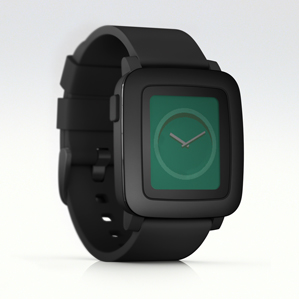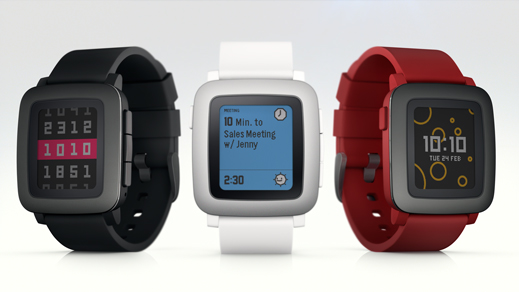A Smart-Watch Pioneer Has an Answer for Apple
If Eric Migicovsky, founder and CEO of smart-watch maker Pebble, is nervous about Apple’s looming entry into his company’s turf, he isn’t showing it.

Sitting in a small conference room in the company’s Palo Alto office on a sunny February morning, Migicovsky seems more excited than apprehensive. And with a bit of showmanship, he pulls a black microfiber cloth away from a table to reveal Pebble’s latest product: a smart watch with a brushed-metal face, white silicone band, and a color e-paper display, across which flies a tiny, animated Nyan Cat—the Internet meme of a pixelated feline with a Pop-Tart body, whizzing through outer space, leaving a rainbow in its wake.
A lot is riding on this watch, called Pebble Time. Pebble is announcing it today, but it’s not going to be available until May. The company is selling it first through a Kickstarter campaign, where it will cost as little as $159 (its eventual retail price will be $199, Migicovsky says). Apple has said it will begin selling the Apple Watch in April.
The Apple Watch, starting at $349, will be a lot pricier than any of Pebble’s offerings. But the iPhone and iPad maker’s proven ability to define new categories in mobile computing could help it take the lead in the smart watch market—a market that Pebble in many ways kicked off by garnering so much attention for its first product.
Migicovsky seems remarkably unfazed. He frames Apple’s interest in the wrist as a compliment to his company, which sold its millionth smart watch late last year. He also seems convinced that Pebble holds an unlikely edge.
“Obviously Apple is a massive company; there’s no denying that,” Migicovsky says (see “Eric Migicovsky, 27”). “But we’re exclusively focused on it. This is what we do.”

Pebble’s new watch is clearly different from the original plastic-bodied, $99 Pebble watch with the black-and-white e-paper display that raised $10 million on Kickstarter in 2012 (see “A Smart Watch, Created by the Crowd, Debuts in Vegas”). It’s also a change from the more recent $199 stainless-steel version, Pebble Steel.
Though the color display isn’t touch-sensitive or as bright and sharp as it would be with a high-resolution screen like the one the Apple Watch will sport, the Pebble Time will, like previous Pebble watches, run up to a week on one battery charge. The new watch also has a microphone to let you speak short responses to notifications—you can send a quick response to an e-mail or make a voice note, for instance, by pressing a button and speaking for up to 15 seconds. The Time is also slimmer than previous Pebbles, and its underside is slightly curved to fit around the wrist.
But the changes run deeper than a color display and some other hardware differences. Pebble Time is built around the idea of a visual timeline that’s meant to show you information like upcoming meetings, local weather, and sports scores at the right times and places.
The idea, Migicovsky says, is to find a more intuitive way to get information out of the device without having to pull out your smartphone or open up apps made by third-party developers (although about 6,500 Pebble apps have been made thus far).
You can tap side buttons on the watch to scroll through timelines showing 24 to 48 hours of your past, present, and future, represented by tidbits of data with simple animations. If you want more information about an upcoming restaurant reservation, you can select it and get directions; if you tire of certain updates, you can turn them off.
The watch has another feature that Pebble hopes will distinguish it from Apple’s: so-called “smart bands,” or straps to be made by third-party developers that can connect more hardware to your Pebble Time when they’re plugged into a port on the underside of the gadget (the straps replace half of the wristband). A strap with an embedded battery, for instance, might give the watch another week of battery life. One with a heart-rate monitor might enable more precise fitness-tracking applications. The company says it is working on smart bands with some as-yet-unnamed companies, and will offer developers files so they can 3-D print a connector that lets the band plug into the watch’s port.
Despite all the enthusiasm, both Pebble and Apple face a fundamental problem: convincing people that they need a smart watch. Market researcher IDC expects gadget makers to ship 62 million wearable devices this year, including smart watches; in contrast, it expects 1.4 billion shipments of smartphones in the same time frame.
Ramon Llamas, research manager for IDC’s wearables and mobile phones team, says Pebble’s lower prices, relative to the Apple Watch, means the two companies occupy two different areas of the smart-watch market.
“That says to me, for people who are price-sensitive, there are devices for you, and Pebble’s going to be one of them,” he says.
Keep Reading
Most Popular
Large language models can do jaw-dropping things. But nobody knows exactly why.
And that's a problem. Figuring it out is one of the biggest scientific puzzles of our time and a crucial step towards controlling more powerful future models.
The problem with plug-in hybrids? Their drivers.
Plug-in hybrids are often sold as a transition to EVs, but new data from Europe shows we’re still underestimating the emissions they produce.
Google DeepMind’s new generative model makes Super Mario–like games from scratch
Genie learns how to control games by watching hours and hours of video. It could help train next-gen robots too.
How scientists traced a mysterious covid case back to six toilets
When wastewater surveillance turns into a hunt for a single infected individual, the ethics get tricky.
Stay connected
Get the latest updates from
MIT Technology Review
Discover special offers, top stories, upcoming events, and more.